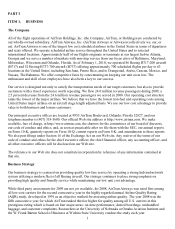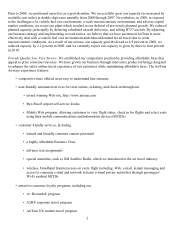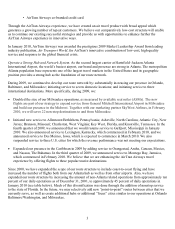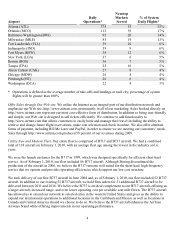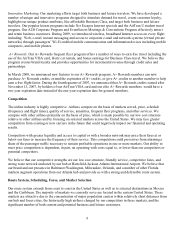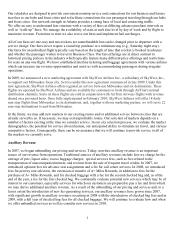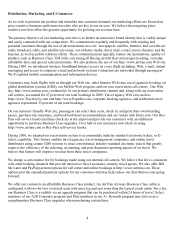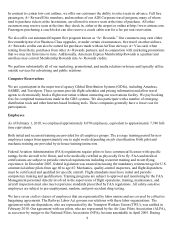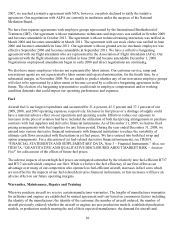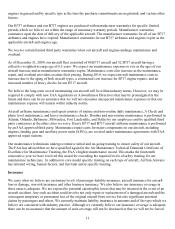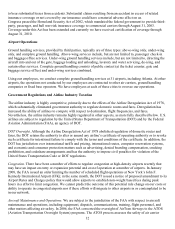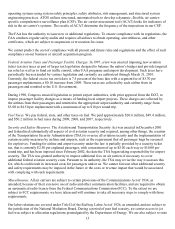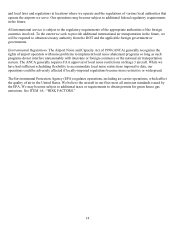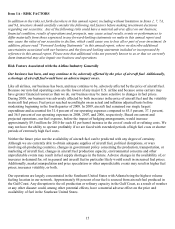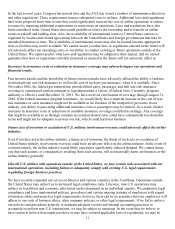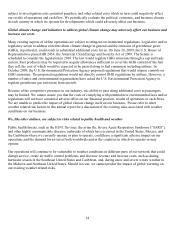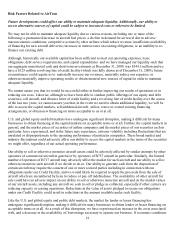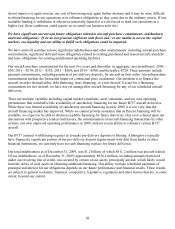Airtran 2009 Annual Report Download - page 19
Download and view the complete annual report
Please find page 19 of the 2009 Airtran annual report below. You can navigate through the pages in the report by either clicking on the pages listed below, or by using the keyword search tool below to find specific information within the annual report.10
2007, we reached a tentative agreement with NPA; however, our pilots declined to ratify the tentative
agreement. Our negotiations with ALPA are currently in mediation under the auspices of the National
Mediation Board.
We have four separate agreements with employee groups represented by the International Brotherhood of
Teamsters (IBT). Our agreement with our maintenance technicians and inspectors was ratified in October 2009
and becomes amendable in October 2013. The agreement with our technical training instructors was ratified in
March 2006 and becomes amendable in March 2011. The agreement with our stock clerks was ratified in June
2006 and becomes amendable in June 2011. Our agreement with our ground service mechanic employees was
effective September 2006 and becomes amendable in September 2011. We have a collective bargaining
agreement with our flight attendants who are represented by the Association of Flight Attendants (AFA). Our
agreement with the flight attendants was ratified in June 2005 and became amendable December 1, 2008.
Negotiations on proposed amendments began in early 2008 and direct negotiations are continuing.
We also have many employees who are not represented by labor unions. Our customer service, ramp and
reservations agents are not represented by labor unions and rejected unionization, for the fourth time, by a
substantial margin, in November 2009. We are unable to predict whether any of our non-union employee groups
will elect to be represented by a labor union or become covered by a collective bargaining agreement in the
future. The election of a bargaining representative could result in employee compensation and/or working
condition demands that could impact our operating performance and expenses.
Fuel
Aircraft fuel is our largest expenditure and accounted for 31.4 percent, 45.5 percent and 37.1 percent of our
2009, 2008, and 2007 operating expenses, respectively. Increases in fuel prices or a shortage of supply could
have a material adverse effect on our operations and operating results. Efforts to reduce our exposure to
increases in the price of aviation fuel have included the utilization of both fuel pricing arrangements in purchase
contracts with fuel suppliers and derivative financial instruments. As of December 31, 2009, we had no fixed
pricing arrangements with fuel suppliers for any future period. During the year ended December 31, 2009, we
entered into various derivative financial instruments with financial institutions to reduce the variability of
ultimate cash flows associated with fluctuations in jet fuel prices. We have entered into both fuel swap and
option arrangements. For a discussion of jet fuel-related derivative financial instruments, see ITEM 8.
“FINANCIAL STATEMENTS AND SUPPLEMENTARY DATA, Note 3 – Financial Instruments.” Also, see
ITEM 7A. “QUANTITATIVE AND QUALITATIVE DISCLOSURES ABOUT MARKET RISK – Aviation
Fuel” for a discussion of the effects of future fuel prices.
The adverse impacts of recent high fuel prices are mitigated somewhat by the relatively new fuel-efficient B737
and B717 aircraft which comprise our fleet. While we believe the fuel efficiency of our fleet offers us an
advantage over many of our competitors who operate less fuel-efficient aircraft, increases in fuel costs which
are not offset by the impacts of our fuel-related derivative financial instruments, or fare increases will have an
adverse effect on our future operating margins.
Warranties, Maintenance, Repairs and Training
When we purchase aircraft we receive certain manufacturer warranties. The lengths of manufacturer warranties
for airframes and engines are established by mutual agreement and vary based on a numerous factors including:
the identity of the manufacturer; the identity of the customer; the number of aircraft ordered; the number of
aircraft previously ordered; whether the aircraft or engines are new production models, established production
models, or production models nearing the end of their expected manufacture; the demand for aircraft and



